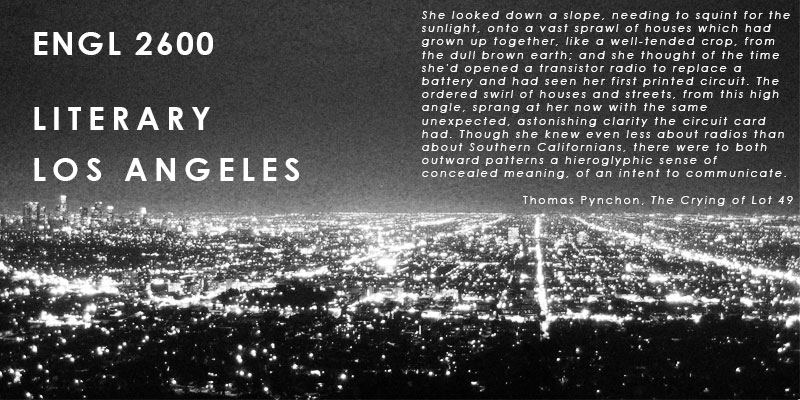Catalog Description
Introduction to the literature of Los Angeles and an examination of the effects of place and culture on the area’s literary production through close study of works about Los Angeles in a variety of genres. GE C2
Course Description
Los Angeles has provided writers, artists, songwriters, and filmmakers with endless opportunities for representation and misrepresentation and the history of Los Angeles has been marked by its paradoxical status as both utopian retreat and apocalyptic terminus. This interest in Los Angeles as myth, symbol, paradox, cautionary tale, utopia, dystopia, has produced a rich and varied literature of Los Angeles. That history of course is much older than the last few years or decades, ranging from the influential work of early Anglo writers, such as Helen Hunt Jackson and Charles Lummis, through the post-WWII genre specialists, such as Raymond Chandler, Ray Bradbury, and Octavia Butler, and the steady stream of refugees from Europe or the frozen East, such as F. Scott Fitzgerald, Thomas Pynchon, and Christopher Isherwood, to the more recent explosion of award-winning writers, such as Luis J. Rodriguez, Charles Bukowski, Wanda Coleman, Luis Valdez, Garrett Hongo, and Anna Deveare Smith.
With its emphasis on local literature and the communities that have produced it and are represented in it, this course embraces the community surrounding the campus and with its emphasis on the multicultural and multi-lingual aspects of Los Angeles literature, seeks to both familiarize and de-familiarize the neighborhoods, communities, and peoples of the city that is home to the majority of our students.
Learning Outcomes
Upon completion of this course, students will be able to:
- Demonstrate knowledge of the history of Los Angeles and the key role of race, class, gender, and sexual orientation in representations of the city and its populace.
- Identify historical and cultural developments that affected literary production.
- Identify and analyze the principal literary genres and conventions that have characterized the literature of Los Angeles.
- Recognize the possible relationships between a text and its historical and cultural context.
- Explain the relationship between place and expression, between Los Angeles and the creative expression of artists in Los Angeles.
- Demonstrate general skills in reading comprehension, critical thinking, literary analysis, and academic writing in the humanities.
Course Outline
Course content might be organized in a number of ways. Listed below is one common method of organizing a literature survey course.
Chronological Structure
Weeks 1-2—English Anglo Writers and the End of the Californios
Weeks 3-4—Hollywood Dreams and Corruption: West, Fitzgerald, and others
Weeks 5-7—Crime and Punishment: Chandler, Mosely and film noir
Weeks 8-10—Race, Class, Gender: Smith, Valdez, and others
Weeks 11-13—Dystopic Imaginings: Science Fiction
Weeks 14-15—Los Angeles, Capital of the Twenty-First Century: LA Poetry
About the Banner: Los Angeles basin at night as seen from the San Gabriel Mountains (image from http://commons.wikimedia.org/wiki/File:Los_Angeles_Basin_at_night.jpg).
